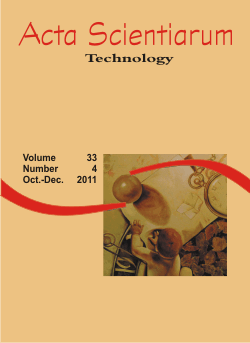Application of microfiltration with ceramic membranes in the separation process of biodiesel and glycerin
DOI:
https://doi.org/10.4025/actascitechnol.v33i4.8252Keywords:
Microfiltration, ceramic membranes, biodiesel, glycerinAbstract
This study investigated the efficiency of microfiltration with ceramic membranes in separating biodiesel and glycerin. Synthetic blends (feed solution) were prepared with mass composition of 80% biodiesel, 10% glycerin and 10% anhydrous ethanol. Runs were performed in the micro and ultrafiltration module, in batch mode, using tangential filtration. Experiments were carried out with Al2O3/TiO2 tubular ceramic membranes with average pore size of 0.2, 0.4 and 0.8 µm, filtration area of 0.005 m2, at 60ºC and transmembrane pressures of 1.0, 2.0 and 3.0 bar. Membrane performance was evaluated based on its capacity to retain glycerin and permeate flux values. The low content of glycerin in the permeate, 0.04-0.1 wt%, demonstrates a high potential with respect to the use of ceramic membranes in the separation stage of biodiesel.Downloads
Download data is not yet available.
Downloads
Published
2011-04-14
How to Cite
Gomes, M. C. S., Ferreira, M. Z., Tonelli, V. P., Barros, S. T. D. de, & Pereira, N. C. (2011). Application of microfiltration with ceramic membranes in the separation process of biodiesel and glycerin. Acta Scientiarum. Technology, 33(4), 415–419. https://doi.org/10.4025/actascitechnol.v33i4.8252
Issue
Section
Chemical Engineering
License
DECLARATION OF ORIGINALITY AND COPYRIGHTS
I Declare that current article is original and has not been submitted for publication, in part or in whole, to any other national or international journal.
The copyrights belong exclusively to the authors. Published content is licensed under Creative Commons Attribution 4.0 (CC BY 4.0) guidelines, which allows sharing (copy and distribution of the material in any medium or format) and adaptation (remix, transform, and build upon the material) for any purpose, even commercially, under the terms of attribution.
Read this link for further information on how to use CC BY 4.0 properly.











8.png)




